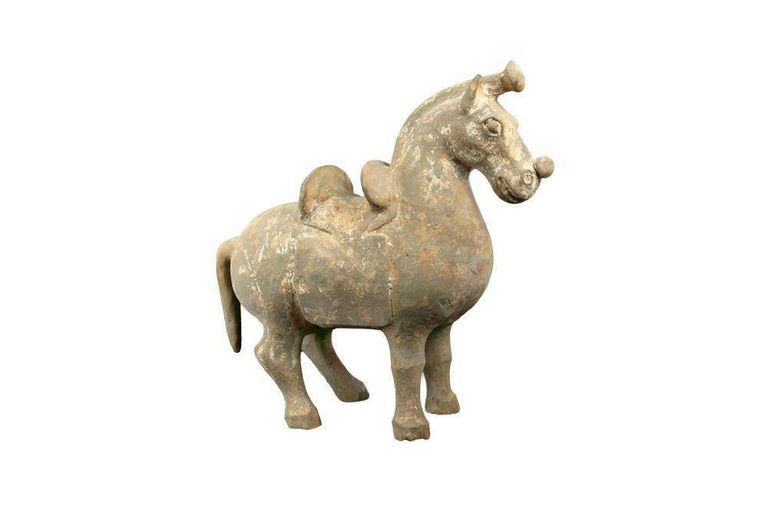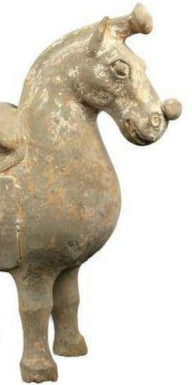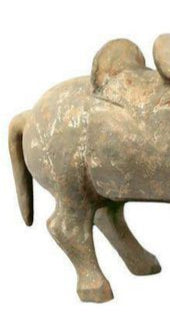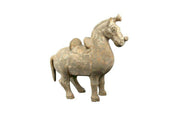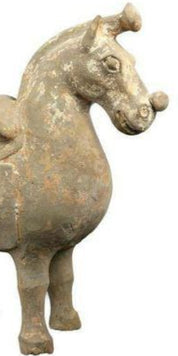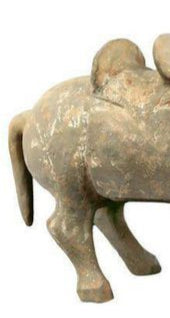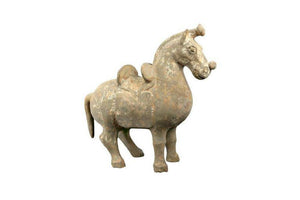Chinese Pottery Model of a Saddled Horse
Title: Chinese Pottery Model of a Saddled Horse
Date Made: Western Jin Dynasty 3rd–4th Century AD
Medium: Pottery
Dimensions: 15.7 inches (L 40 cm)
Artwork Identification:
This Chinese pottery model of a saddled horse, from the Western Jin Dynasty, stands solidly four-square with a stocky body and stylized foretop. The horse is equipped with a saddle, and its short legs and sturdy build reflect the characteristics of the Mongolian breed, which was preferred in the Western Jin era. The model, which measures 40 cm in length, showcases the typical Western Jin approach to equestrian figures, marked by a more robust and less graceful form compared to earlier Han Dynasty models.
Artistic Style and Influences:
During the Western Jin Dynasty (265–420 AD), pottery figures were often modeled after the stocky and short-legged Mongolian horses, reflecting their practical use and the preferences of the time. This contrasts with the more elegant and refined horse models of the Han Dynasty, which were typically more slender and graceful. The pottery model demonstrates the Western Jin’s adaptation of equestrian forms, with a more stylized and robust appearance. The technique of joining two parts of the model, with details like the tail, mane, and saddle added later, is indicative of the period's ceramic practices.
Historical Context:
The Western Jin Dynasty was a period of transition in China, marked by significant shifts in culture and art. Pottery figures from this era often reflect the practical aspects of daily life and the evolving artistic styles. The preference for stocky horses in Western Jin ceramics highlights the utilitarian and military importance of these animals during the period. The approach to pottery making, including the assembly of multiple parts, reflects the evolving techniques and materials used in Chinese ceramic production.
Provenance and Authenticity:
This pottery model of a saddled horse is an authentic piece from the Western Jin Dynasty, reflecting the era's distinctive style and artistic practices. The model’s robust form and construction techniques align with known examples of Western Jin ceramics. While specific provenance details are not provided, its style and craftsmanship confirm its historical origins.
Condition and Conservation:
The model is in good condition, with its robust form and saddle details well-preserved. There may be minor signs of wear consistent with its age, but the overall integrity of the piece remains intact. No significant damage is noted, though it is advisable to handle and store the model carefully to maintain its condition.
Artistic Significance:
This Western Jin pottery model of a saddled horse provides valuable insight into the evolution of Chinese ceramic art and the practical aspects of equestrian life during the period. The model’s robust and stylized form, along with the construction techniques used, exemplify the artistic and cultural shifts of the Western Jin Dynasty. As a historical artifact, it contributes to the understanding of the era’s artistic practices and the importance of horses in Chinese society.



































